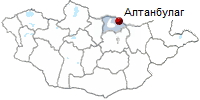Selenge Aimag. Sukhbaatar. Darkhan. Kharagiin Monastery (Kharagiin Khiid). Bugant. Amarbayasgalant monastery (Khiid).
THE REGIONS OF MONGOLIA
SELENGE AIMAG
ALTANBULAG


Selenge aimag is located in the North part of Mongolia in a beautiful basin of Orkhon and Selenge rivers. Selenge is the first - or last - aimag seen by
train travelers shuttling between Ulaanbaatar and Russia. There is not a lot to attract visitors to Selenge except the majestic, but remote, monastery
Amarbayasgalant monastery and some beautiful scenery.
Altanbulag. Just 24km to the East of Sukhbaatar is Altanbulag, a small, peaceful border town in the sum of the same name. Just on the other side of the
border is the Russian city of Kyakhta. From the border, you can easily see the abandoned, but once opulent, Kyakhta Cathedral. The Mongolian government recently
decided to allocate 500 hectares at Altanbulag as a Free Trade Zone for the development of trade with Russia. Hopefully, this will be more successful than the
Free Trade Zone in Choir, in Domogov aimag.
Altanbulag began as a trading outpost across the Kyakhta River from the
Russian town of Kyakhta during Qing rule of Mongolia in 1730. The name of that
city was called Maimaicheng (Mongolian: Худалдаачин, English: City of Buying and
Selling) at the first and later renamed to Kyakhta (Mongolian: Khiagt). Also
people used other names such as "Mongolian Khyahta" and "Southern Kyakhata".
The twin towns of Kyakhta and Maimaicheng can be seen on this 1851 map, on
the shortest route from Irkutsk to Pekin.
Following the Treaty of Kyakhta in 1727 each side built a trading post on its
side of the border. Construction began in 1730. It was perhaps 500 to 700 feet
south of Kyakhta, upstream on the small Kyakhta River. The town was square, with
wooden walls and, after 1756, a three-foot wide ditch. Each wall had a gate
which led to two major streets which intersected in the center. Each gate had a
25-foot watchtower manned by members of the Mongol garrison. The main avenues
were about 25 feet wide, but the other streets and alleys were narrow. The
larger houses had interior courtyards where trading was done. These courtyards
were generally better kept than the public areas. The southwestern quarter of
town was occupied by "Bukharans" as the Russians called traders from Central
Asia. Women were forbidden to live in the town, apparently to keep Chinese
merchants from becoming permanent residents. The rule was evaded but still in
force in 1908. The post was administered by the 'Dzgarguchei' who was replaced
by the Lifanyuan every two years. For some purposes the Dzarguchei dealt with
the Tushetu Khan in Urga who was partly supervised by a Manchu resident.
At a meeting in Kyakhta in March 1921, the Mongolian People's Party was formed by Mongolian revolutionaries in exile, and the
revolutionary hero Sukhbaatar was named minister of war.
This government went on to oust the government of Roman Ungern von Sternberg and
later formed the Mongolian People's Republic in 1924.
The Museum of Selenge Province (Mongolian: Сэлэнгэ Аймгийн Нэгдсэн
Музей) is a museum in Altanbulag, Selenge Province, Mongolia. The museum was
originally established in 1948. In 1968, it was updated to a local museum. In
2004, the museum was merged with Museum of Altanbulag.[In January 2023, the
museum underwent renovation. The museum exhibits artifacts related to nature,
ethnography and objects related to Selenge Province. The museum also exhibits
history of Mongolian Revolution of 1921.
INFORMATION:
PAGES OF THE PICTURE ALBUM
|